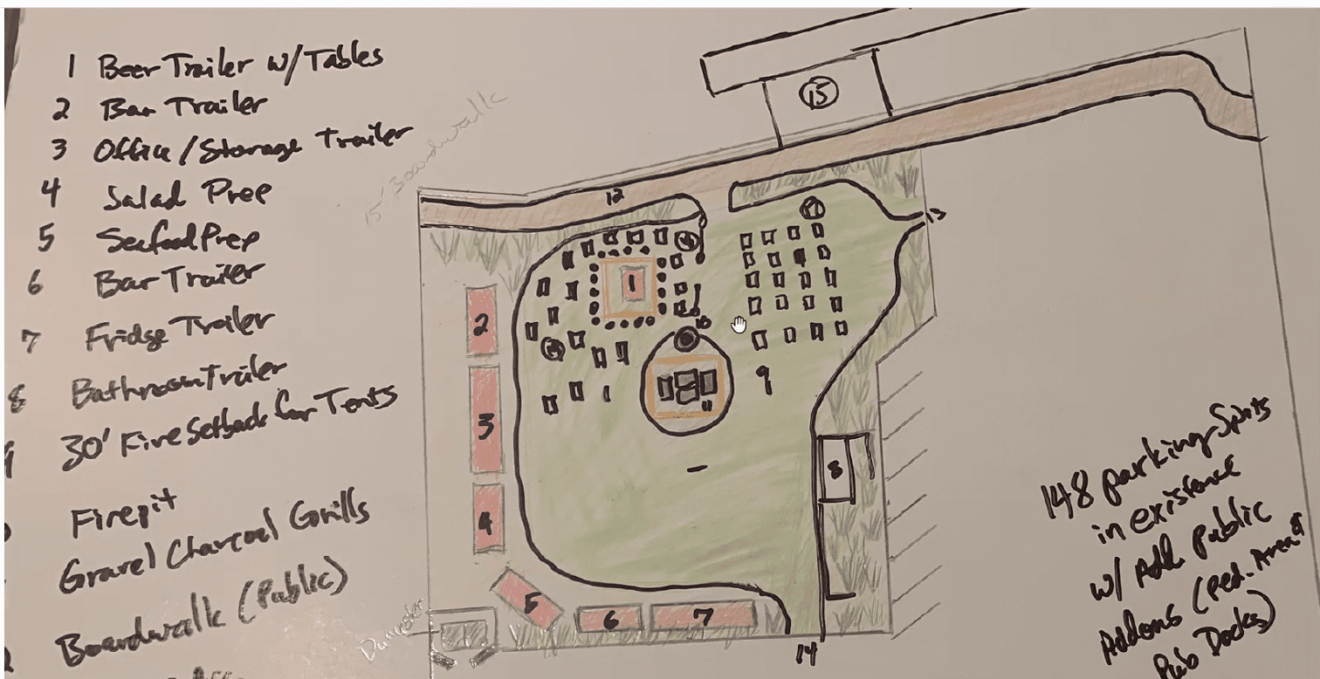OLD SAYBROOK — Two restauranteurs are proposing to open a seasonal outdoor restaurant using towable food trailers at the former Dock & Dine property at 145 College St near the mouth of the Connecticut River.
“Essentially they’re like trailers, like a food truck hall, but the new ones are very sleek looking they’re very modernized,” said Colt Taylor, chef of The Essex and Los Charros Cantina in Essex, who is working on the project with Jon Kodama, owner of the property since 1987 and managing partner of JTK Management Restaurants, the group that owns the former Dock & Dine as well as Breakwater in Stonington and Go Fish and Steak Loft in Mystic.
The concept would allow a new restaurant to be “built” on the 2.23-acre site that is located in a floodplain with an elevation of four feet, which would otherwise require constructing a building at a 13-foot elevation for compliance with the flood zone hurricane regulations of the Federal Emergency Management Agency.
Taylor brought the idea to the Old Saybrook Zoning Commission on January 4 to ask for feedback and returned on Jan. 20 with a preliminary sketch of the layout.
“It is really geared to be a restaurant space without the walls, if you will. Rather than walls we have perimeter sand around the entire outside between the asphalt and the grass with, hopefully, seagrass plantings that would act as a barrier outside of [the] entrances,” Taylor said.

The restaurant would consist of eight trailers that could be towed away in the event of severe weather or a hurricane. One would be a mobile beer trailer with fold-out bar seating, in an area roped off for adults 21 and older. Several other trailers would be used for storage. Two trailers would be used for cold prep — one for seafood and one for salads.
“I think it is very important that none of our cooking trailers have hoods or grease of any kind and they’re all cold-prep trailers which means stainless steel-lined, done for salads, raw bar seafood prep, things of that nature,” he said.
The only cooking on site would be in four charcoal-barrel smokers, each six feet long by three feet wide, clustered together in a fire pit.
One trailer would house portable restrooms, Taylor said.
“I don’t want to call them porta potties because they’re not. They are portable restrooms. They would have running water and they would have the plug-in to the septic,” he said
In the offseason, once the tables and trailers were removed, the property will resemble a park because the restaurant will have minimal impact on the land, he said, although whether the space could then be used as a public park is a question of insurance liability.
Zoning hurdles
The biggest impediment to the project is that the town only allows indoor dining in its zoning regulations. Taylor and his attorney, Ed Cassella, provided the Zoning Commission with a draft text amendment that would add outdoor dining as a new category.
Robert Friedmann, chair of the Zoning Commission, said some of the zoning issues of concern were related to smoke, odors, noise and lighting.
In addition, the town has regulations on seven kinds of trailers in its definition section, Friedmann said, and this project would have to differentiate itself from the other categories.
“If what you have is on wheels, how is it not a trailer, and how is it not regulated by the section on trailers — that would be something that you’d have to work out in terms of a proposal,” he said.
The project also proposes putting up tents on the property, but Friedmann warned that if a tent has sides then it becomes a building and will be subject to setback and separation regulations.
The project would likely require a storm contingency plan with defined parameters for evacuation and a seasonal removal plan incorporated into the development of an application for zoning approval, said Cassella.
Taylor said he and Kodama met with Diane Ifkovic at the Department of Energy and Environmental Protection to discuss whether the use of temporary movable structures have been allowed in floodplain areas on a seasonal basis.
Mobile units
“Essentially it’s one of those hookups you see out at the dock for the boats to hook up to, so it has water with backflow prevention as well as electric that you just plug into with a big marine grade port,” Taylor said of the hookups the trailers would use for utilities.
In the event of bad weather or a hurricane, the disconnection process is quick, he said.
“It just leaves a small, very safe stub there in its place to withstand any weather and it allows us to be ‘disaster preparedness’ all the way,” he said.
Taylor said the trailers would differ from food trucks which offer take-out exclusively, and would provide sit-down dining and a bar that was a throwback to the 70s and 80s.
He said the trailers concept would keep the land open and preserve the natural beauty of the area.
“It’s celebrating the view — everybody has waterfront dining. There’s nobody fighting like at the old Dock & Dine for that window seat because everybody’s sitting in the open, and what you’re doing is you’re bringing life and fun pleasure to the the shoreline without putting a monstrosity 40 feet in the air, blocking the view from people in the parking lot and everything else,” he said.

